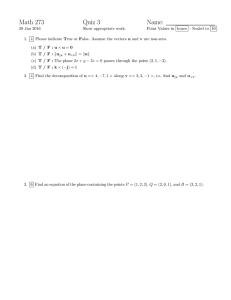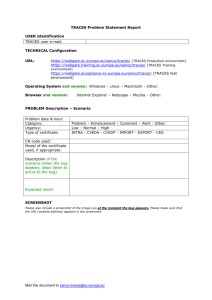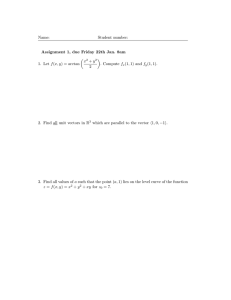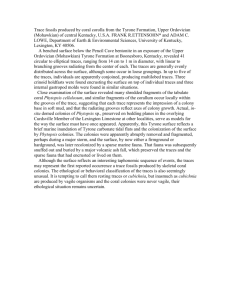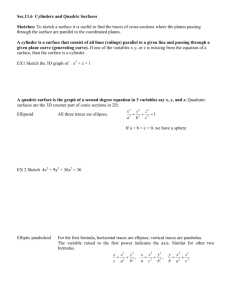Action-Model Acquisition from Noisy Plan Traces
advertisement
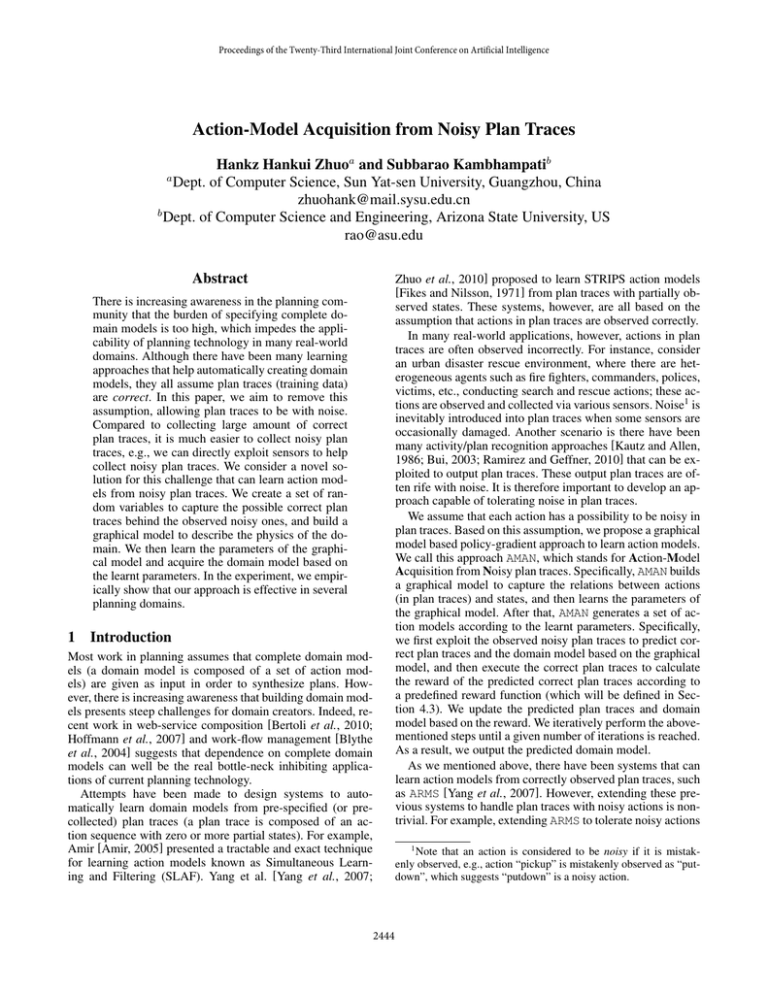
Proceedings of the Twenty-Third International Joint Conference on Artificial Intelligence
Action-Model Acquisition from Noisy Plan Traces
Hankz Hankui Zhuoa and Subbarao Kambhampatib
a
Dept. of Computer Science, Sun Yat-sen University, Guangzhou, China
zhuohank@mail.sysu.edu.cn
b
Dept. of Computer Science and Engineering, Arizona State University, US
rao@asu.edu
Abstract
Zhuo et al., 2010] proposed to learn STRIPS action models
[Fikes and Nilsson, 1971] from plan traces with partially observed states. These systems, however, are all based on the
assumption that actions in plan traces are observed correctly.
In many real-world applications, however, actions in plan
traces are often observed incorrectly. For instance, consider
an urban disaster rescue environment, where there are heterogeneous agents such as fire fighters, commanders, polices,
victims, etc., conducting search and rescue actions; these actions are observed and collected via various sensors. Noise1 is
inevitably introduced into plan traces when some sensors are
occasionally damaged. Another scenario is there have been
many activity/plan recognition approaches [Kautz and Allen,
1986; Bui, 2003; Ramirez and Geffner, 2010] that can be exploited to output plan traces. These output plan traces are often rife with noise. It is therefore important to develop an approach capable of tolerating noise in plan traces.
We assume that each action has a possibility to be noisy in
plan traces. Based on this assumption, we propose a graphical
model based policy-gradient approach to learn action models.
We call this approach AMAN, which stands for Action-Model
Acquisition from Noisy plan traces. Specifically, AMAN builds
a graphical model to capture the relations between actions
(in plan traces) and states, and then learns the parameters of
the graphical model. After that, AMAN generates a set of action models according to the learnt parameters. Specifically,
we first exploit the observed noisy plan traces to predict correct plan traces and the domain model based on the graphical
model, and then execute the correct plan traces to calculate
the reward of the predicted correct plan traces according to
a predefined reward function (which will be defined in Section 4.3). We update the predicted plan traces and domain
model based on the reward. We iteratively perform the abovementioned steps until a given number of iterations is reached.
As a result, we output the predicted domain model.
As we mentioned above, there have been systems that can
learn action models from correctly observed plan traces, such
as ARMS [Yang et al., 2007]. However, extending these previous systems to handle plan traces with noisy actions is nontrivial. For example, extending ARMS to tolerate noisy actions
There is increasing awareness in the planning community that the burden of specifying complete domain models is too high, which impedes the applicability of planning technology in many real-world
domains. Although there have been many learning
approaches that help automatically creating domain
models, they all assume plan traces (training data)
are correct. In this paper, we aim to remove this
assumption, allowing plan traces to be with noise.
Compared to collecting large amount of correct
plan traces, it is much easier to collect noisy plan
traces, e.g., we can directly exploit sensors to help
collect noisy plan traces. We consider a novel solution for this challenge that can learn action models from noisy plan traces. We create a set of random variables to capture the possible correct plan
traces behind the observed noisy ones, and build a
graphical model to describe the physics of the domain. We then learn the parameters of the graphical model and acquire the domain model based on
the learnt parameters. In the experiment, we empirically show that our approach is effective in several
planning domains.
1
Introduction
Most work in planning assumes that complete domain models (a domain model is composed of a set of action models) are given as input in order to synthesize plans. However, there is increasing awareness that building domain models presents steep challenges for domain creators. Indeed, recent work in web-service composition [Bertoli et al., 2010;
Hoffmann et al., 2007] and work-flow management [Blythe
et al., 2004] suggests that dependence on complete domain
models can well be the real bottle-neck inhibiting applications of current planning technology.
Attempts have been made to design systems to automatically learn domain models from pre-specified (or precollected) plan traces (a plan trace is composed of an action sequence with zero or more partial states). For example,
Amir [Amir, 2005] presented a tractable and exact technique
for learning action models known as Simultaneous Learning and Filtering (SLAF). Yang et al. [Yang et al., 2007;
1
Note that an action is considered to be noisy if it is mistakenly observed, e.g., action “pickup” is mistakenly observed as “putdown”, which suggests “putdown” is a noisy action.
2444
we assume Ao = {noop} ∪ A. An observed action sequence
is allowed to be with noise, i.e., some actions in a plan trace
may be mistakenly observed. Our problem can be defined by:
given as input a set of observed plan traces T o , our approach
outputs a domain model m that best explains the observed
plan traces. We assume that there is a correct plan trace t for
each observed plan trace to , where the length of t (the number
of actions in t) is the same as to , i.e., |t| = |to |. An example
of our learning problem can be found in Table 1. The gray
parts of the input plan traces are mistakenly observed actions
(i.e., noisy actions), e.g., “(pickup A)” is a noisy action that
should be “(unstack A C)”.
in plan traces requires adding or removing constraints from
ARMS to tolerate noise. However, either way of adding or removing constraints is hard to capture the information about
the probabilistic distribution of noisy actions in plan traces in
the MAX-SAT [LI et al., 2007] framework which is used by
ARMS. Considering the difficulty in extending previous systems, we explore a novel approach which is based on graphical model, as addressed above.
We organize the paper as follows. We first review related
work, and then present the formal definition of our learning
problem. After that, we give the detailed description of the
AMAN algorithm. Finally, we evaluate AMAN in three planning
domains, and conclude the paper with future work.
2
Table 1: An example of our learning problem.
Related Work
Learning action models from plan traces has had a long
history. Previous research efforts differ mainly on whether
plan traces consist of actions as well as intermediate states
(c.f. [Gil, 1994]) or only actions (c.f. [Yang et al., 2007;
Zhuo et al., 2010; 2011]). While the later assumption makes
the problem harder than the former, in both cases, whatever is
observed is assumed to be observed perfectly. In contrast, our
work focuses on learning from noisy (imperfectly observed)
plan traces. While there has been previous work on learning probabilistic action models (e.g. [Pasula et al., 2007] and
[Zettlemoyer et al., 2005]), they too assume non-noisy plan
observations. Work on plan recognition (e.g. [Zhuo et al.,
2012; Bui, 2003]) has of course considered recognizing plans
from noisy/missing observations, but they typically assume
that they know the action model. Our problem is however significantly complicated by the fact that we need to learn the
action model given only noisy plan traces. One recent effort
that does take imperfectly sensed plan traces into consideration is that by Mourao et al. [Mourao et al., 2012], who allow
for noisy observations of the intermediate states. They however assume that the actions are observed without noise.
3
Input:
Output:
plan trace #1: s10 , (pickup A), (putdown A),
noop, (stack B A), g 1
plan trace #2: s20 , (pickup a), (putdown a),
(pickup b), (stack b a), g 2
(— other plan traces omitted —)
(:action (pickup ?x - block)
(:precondition (ontable ?x) (handempty)
(clear ?x))
(:effects (and (holding ?x) (not (ontable ?x))
(not (clear ?x)) (not (handempty)))))
(— other action models omitted —)
s10 :{(on A C) (ontable C) (clear A) (ontable B) (clear B) (handempty)}; g 1 :{(ontable A) (on B A)}.
s20 : {(ontable a) (ontable b) (clear a) (clear b) (ontable c)
(clear c) (handempty)}; g 2 : {(on a c) (on b a)}.
4
The AMAN Approach
Consider a domain model m to be a set of action models. Given a set of action schemas and a set of predicates,
we can generate a finite set of domain models (denoted by
M = {m}) by enumerating all possible combinations of action schemas and predicates. Our objective is to find a domain model m∗ ∈ M that best explains the observed plan
traces. To do this, we perform the following steps. We first extract action schemas Ā and predicates P from the input plan
traces, and build a set of domain models M with Ā and P .
We then build a graphical model according to the causal relations between states si , correct actions ai , observed actions
aoi (probably noisy) and domain models m. We finally learn
the graphical model using the input plan traces and output
the target domain model m∗ . In summary, we first build a set
of candidate domain models M . We then build a graphical
model to capture the domain physics. After that we learn the
graphical model to predict the best domain model m∗ . In the
following subsections, we describe the idea in detail.
Preliminaries and Problem Formulation
A planning problem is defined by s0 , g, m, where s0 is an
initial state, g is a goal, and m is called a domain model that is
composed of a set of action models. An initial state or a goal is
composed of a set of propositions. An action model is defined
by a, P re, Add, Del, where a is an action name with zero
or more variables (as parameters), P re, Add and Del are precondition list, add list and delete list, respectively. In the paper we will use P re(a) to denote a list of preconditions of action a, likewise for Add(a) and Del(a). Note that we follow
the STRIPS language definition [Fikes and Nilsson, 1971]
action models. We call an action with zero or more parameters (variables) an action schema, a set of which is denoted by
Ā. We denote the set of action instances of a planning problem by A. A solution to a planning problem is a plan, which
is composed of an action sequence a1 , a2 , . . . , an , where
ai ∈ A.
Let T o = {s0 , ao1 , . . . , aon , g} be a set of observed plan
traces, where aoi ∈ Ao is an observed action, and Ao is a set of
possible observed actions. We assume the empty action noop
(that does nothing) is also an element of Ao . For simplicity,
4.1
Building Candidate Domain Models
In this subsection, we extract action schemas and predicates
from input plan traces. We first scan each action in plan traces
and substitute its instantiated parameters with their corresponding variables to build an action schema. In this way we
2445
can build a set of action schemas Ā. Likewise, we scan each
initial state and goal in plan traces to collect a set of predicates P . As an example, from the two plan traces in Table
1, we can build action schemas Ā={(pick ?x - block), (putdown ?x - block), noop, (stack ?x - block ?y - block)}, and
predicates P ={(on ?x - block ?y - block) (ontable ?x - block)
(clear ?x - block) (handempty)}.
With action schemas Ā and predicates P , we further build
all possible candidate domain models M based on STRIPS
description [Fikes and Nilsson, 1971]. Each domain model
m ∈ M should satisfy the following constraints (which
would help reduce the model space):
while si (0 < i < n), ai and m are “hidden” variables whose
values need to be “guessed”.
To predict the correct plan traces and action models, we
define the conditional probability of t = s0 , a1 , . . . , an , sn and action model m given to = s0 , ao1 , . . . , aon , sn as follows:
p(t, m|to ) ∝ p(t, m, to ).
(1)
o
Based on the graphical model in Figure 1, p(t, m, t ) can be
calculated by
p(t, m, to ) = p(m)p(s0 )
p(t, m, to ) = p(m)p(s0 )
p(ai+1 |si , aoi+1 , m).
(3)
We assume that each domain model m ∈ M is associated
with a weight wm (the weights of all domain models are denoted by w
= wm m∈M ), and p(m) is defined by
wm
.
p(m) = m ∈M wm
Modeling Domain Dynamics
In this subsection we build a graphical model to capture the
relations between state si , action ai+1 (the correct action),
action aoi+1 (the observed action) and domain model m. Intuitively, the probability of action ai+1 depends on its previous
state and the domain model since ai+1 depends on whether
it can be applied on its previous state si according to the domain model m; and it also depends on its corresponding observed action since the more similar to the observed action
aoi+1 the candidate correct action ai+1 is, the more likely the
correct action ai+1 happens. Furthermore, the probability of
new state si+1 depends on its previous state si , its previous
action ai+1 and the current domain model m, since si+1 is
attained by applying ai+1 to si and changing si to si+1 according to m (or the effect of ai+1 ). We thus build a graphical
model as shown in Figure 1. Note that in Figure 1 sn is the
same as g. Note that in Figure 1, s0 , aoi and sn can be attained
According to Equations (1) and (3), we have
p(t, m|to ) ∝ wm
m ∈M
w m
p(s0 )
n−1
i=0
p(ai+1 |si , aoi+1 , m).
(4)
We model the distribution p(ai+1 |si , aoi+1 , m) over the
action space in a log-linear fashion [Pietra et al., 1997;
Lafferty et al., 2001], giving us the flexibility to incorporate
a diverse range of features. With this representation, the distribution is:
exp(θ · f (ai+1 , si , aoi+1 , m))
p(ai+1 |si , aoi+1 , m) = ,
o
ai+1 exp(θ · f (ai+1 , si , ai+1 , m))
(5)
where f (ai+1 , si , aoi+1 , m) = f1 , . . . , fk is an kdimensional feature representation, and θ is a k-vector that
includes parameters to be determined. k is the number of features that are used to model the domain. We use 10 features
in our experiment to describe domains. The following are example features we exploit (note that it is possible to exploit
more features for further extension):
• f1 (applicability of ai+1 ): the value of this feature is one
if ai+1 can be applied on si according to m; otherwise,
it is zero;
• f2 (applicability of aoi+1 ): the value of this feature is one
if aoi+1 can be applied on si according to m; otherwise,
it is zero;
m
si+1
n−1
i=0
In this way, we can enumerate all the possible domain models
M and view them as a set of candidate domain models.
ai+1
(2)
Since we focus on deterministic models, there is only one
state si+1 achieved when applying action ai+1 to state si
based domain model m. As a result, p(si+1 |ai+1 , si , m) is 1,
and 0 for other states si+1 . Thus, Equation (2) can be reduced
to:
• For each action a, there is at least one precondition and
one effect (adding or deleting effect), i.e., P re(a) = ∅ ∧
(Add(a) ∪ Del(a)) = ∅.
si
p(si+1 |ai+1 , si , m) .
• For each action a and predicate p, where p’s parameters
are included by a’s parameters, if p is a precondition of
a, then p should not be an adding effect at the same time,
i.e., p ∈ P re(a) → p ∈ Add(a).
s0
p(ai+1 |si , aoi+1 , m)×
i=0
• For each action a and predicate p in the model m, where
p’s parameters are included by a’s parameters, if p is an
adding effect of a, then p should not be a deleting effect
at the same time, i.e., p ∈ Add(a) → p ∈ Del(a).
4.2
n−1
sn
aoi+1
Figure 1: The graphical model of our learning problem.
from the input observed plan traceto = s0 , ao1 , . . . , aon , sn ,
2446
• f3 (number of parameters): the value of this feature is
one if ai+1 and aoi+1 have the same number of parameters; otherwise, it is zero;
Expanding the inner partial derivative from Equations (8) and
(9) we observe that
∂
∂
log p(t, m|to ) =
log p(ai+1 |si , aoi+1 , m) =
∂ θ
i ∂θ
{f (ai+1 , si , aoi+1 , m) −
[f (ai+1 , si , aoi+1 , m)
• f4 (shared objects): the value of this feature is one if
ai+1 and aoi+1 share some common objects; otherwise it
is zero;
• Features from f5 to f10 are extracted to describe the similarity between ai+1 and aoi+1 regarding their precondition lists, add lists, delete lists, as well as their semantics in real applications, such as “directions” of these
actions.
p(ai+1 |si , aoi+1 , m)]},
(10)
and
∂
wm
∂
log p(t, m|to ) =
log .
∂w
∂w
m ∈M wm
With features defined, the distribution p(t, m|to ) only depends on parameters θ and w.
In the following, we will
present the details of learning parameters θ and w.
4.3
∂
o
=
We denote δ1
log p(t, m|t ) and δ2
∂θ
∂
o
∂w
log p(t, m|t ). Then we have
Learning Parameters
θ = θ + r(t, m) · δ1 ,
With the correct plan trace t predicted, we aim to maximize
the expected value function based on the predefined reward
function:
o
o
(6)
Vθ,
w
(t ) = Ep(t,m|t ) [r(t, m)],
(11)
=
(12)
and
w
=w
+ r(t, m) · δ2 .
(13)
We can see that Equations (10) and (11) are straightforward to compute. However, the complete derivatives of Vθ,
w
in Equations (8) and (9) are intractable to compute since the
expectation requires enumerating all possible plan traces t (as
well as domain models m). Fortunately, policy gradient algorithms employ stochastic gradient ascent by computing an estimate of the expectation using just a subset of possible plan
traces. Specifically, we perform the sampling procedure by
the following two steps:
1. We draw a sample domain model m from M based p(m)
provided that w
was beforehand computed or initialized.
2. We then draw a sample plan trace t by (a).
first drawing action ai+1 based on the distribution
p(ai+1 |si , aoi+1 , m) provided that θ and si were computed or initialized and m was drawn in the first step,
(b). and then computing a new state si+1 by directly applying ai+1 to si based on m.
where r(t, m) is a reward function that specifies the reward
attained after executing t, m. Note that r(t, m) can be defined
in various ways. In our experiment, we define r(t, m) by
r(t, m) = λa (t, m) · λp (t, m),
ai+1
i
(7)
where λa (t, m) is the percentage of actions successfully executed in t and λp (t, m) is the percentage of propositions in
the goal of t achieved after the last successfully executed action. The intuition behind this definition is that the more percentage of actions are successfully executed, the more likely
the predicted plan trace t is correct; and the more percentage
of propositions in goal are achieved, the more likely the plan
trace t is correct.
The learning problem is to find the parameters θ and w
o
(t
)
from
Equation
6.
Although
there
is
that maximize Vθ,
w
no closed form solution, policy gradient algorithms [Sutton et
al., 2000] are capable of estimating the parameters θ and w
by
performing stochastic gradient ascent. The gradient of Vθ,
w
is approximated by interacting with the environment, and the
resulting reward is used to update the estimate of θ and w.
Policy gradient algorithms optimize a non-convex objective
and are only guaranteed to find a local optimum. However, as
we will see, they scale to large state spaces and can perform
well in practice.
To find the parameters θ and w
that maximize the objective,
we compute the derivative of Vθ,
w
. Expanding the derivative
according to the product rule, we have (note that p(s0 ) is a
prior probability which is viewed as 1):
∂
∂
o
o
o
Vθ,
w
(t ) = Ep(t,m|t ) r(t, m) log p(t, m|t ) , (8)
∂ θ
∂θ
4.4
Overview of AMAN
As an overview of AMAN, we show the learning procedure in
Algorithm 1.
Our AMAN algorithm framework belongs to a family of policy gradient algorithms, which have been successfully applied
to complex problems (e.g., robot control [Ng et al., 2003],
natural language processing [Branavan et al., 2012]). Our formulation is unique in how it learns action models in the planning community.
5
Experiments
5.1
Training Data and Criterion
We evaluate our AMAN algorithm in three planning domains
blocks2 , depots3 and driverlog2 which are IPC (International
Planning Competition) benchmark domains. We generate 200
noisy plan traces (training data) by the following steps:
and
∂
∂
o
o
V (t ) = Ep(t,m|to ) r(t, m)
log p(t, m|t ) . (9)
∂w
θ,w
∂w
2
3
2447
http://www.cs.toronto.edu/aips2000/aips-2000datafiles.tgz
http://planning.cis.strath.ac.uk/competition/
Algorithm 1 An overview of our AMAN framework.
Input: a set of plan traces: T o = {to }.
Output: a domain model m∗ .
and w
1: initialize θ
with random values, and set an iteration
number R;
2: for r = 1 to R do
3:
for each to = s0 , ao1 , . . . , aon , g ∈ T do
4:
sample t and m based on p(t, m|to );
5:
calculate the reward r(t, m) based on Equation (7);
6:
update θ and w
based on Equations (12) and (13);
7:
end for
8: end for
9: m∗ = arg maxm∈M wm ;
10: return m∗ ;
and define the accuracy as Acc = 1 − Err(m). Note that
domain model m is composed of a set of action models.
5.2
We evaluated our AMAN algorithm in the following aspects.
We first studied how the accuracy of the model learned by
AMAN varies with respect to increasing number of iterations
R. In doing this, we considered both noisy inputs and noiseless inputs. We are interested in seeing whether AMAN’s accuracy on noisy inputs converges to its accuracy on noiseless traces. We also compared the performance of AMAN on
noiseless input traces to ARMS [Yang et al., 2007] one of
the state-of-the-art action model learning systems (which assumes noiseless input traces). Finally, we studied the running
time of AMAN. In all experiments we ran AMAN three times to
calculate an average of accuracies.
• We first generate a set of correct plan traces {t} by using a planner (such as FF4 ) to solve randomly generated planning problems, assuming correct action models
(ground truth action models) are available.
and calculate the
• We then randomly assign values to θ,
o
conditional distribution p(ai+1 |si , ai+1 , m) of observed
actions given state si , action ai+1 , θ and ground truth
action models m (similar to Equation (5)). Note that si
can be generated by executing actions in the first step
and ai+1 is a correct action generated by the first step.
• We finally sample 200 noisy plan traces {to } based
on p(aoi+1 |si , ai+1 , m). Each noisy plan trace to corresponds to a correct plan trace t generated by the first
step.
We define the accuracy of our AMAN algorithm by comparing its learned action models with the artificial action models which are viewed as the ground truth. We define the error
rate of the learning result by calculating the missing and extra
predicates of the learned action models. Specifically, for each
learned action model a, if a precondition of a does not exist
in the ground-truth action model, then the number of errors
increases by one; if a precondition of the ground-truth action
model does not exist in a’s precondition list, then the number of errors also increases by one. As a result, we have the
total number of errors of preconditions with respect to a. We
define the error rate of preconditions (denoted as Errpre (a))
as the proportion of the total number of errors among all the
possible preconditions of a, that is,
the total number of errors of preconditions
Errpre (a) =
.
all the possible precondition of a
Likewise, we can calculate the error rates of adding effects
and deleting effects of a, and denote them as Erradd (a) and
Errdel (a) respectively. Furthermore, we define the error rate
of all the action models m (denoted as Err(m)) as the average of Errpre (a), Erradd (a) and Errdel (a) for all the actions a in m, that is,
1 Errpre (a) + Erradd (a) + Errdel (a)
,
Err(m) =
|m| a∈m
3
4
Experimental Results
Accuracy on noisy input traces w.r.t. #iterations R
To test the change of accuracies with respect to the number
of iterations R, we varied R from 500 to 2500 and calculated
their corresponding accuracies. We tested two cases “without
noise” and “with noise” in plan traces, where “without noise”
suggests all plan traces are all correct and we do not need
to sample t (as done below in the experiment comparing to
ARMS), and “with noise” suggests we directly run Algorithm
1 with any change. The results are shown in Figure 2.
From Figure 2, we can see that the accuracies of both cases
generally become larger when the value of R becomes larger.
This indicates that high-quality domain models (with respect
to maximally satisfying plan traces) are enhanced, which are
guaranteed by the convergence property of AMAN. We also
observe that the accuracies of the case “with noise” become
more and more close to “without noise” as the value of R becomes larger. This is because the distribution of noise in plan
traces becomes more and more close to the real distribution
when the number of iterations increasing. In other words, the
value of θ is close to the real value that we randomly fixed for
generating noise of plan traces in Section 5.1. By observing
the results of the three testing domains, we can see the accuracies of the case with noise are larger than 0.8 when R is set
to be 1500.
Comparison between AMAN and ARMS on noiseless inputs
Since the “without noise” case is also solved by ARMS, we
would like to compare the “without noise” case of AMAN to
ARMS to see the performance of AMAN. Since ARMS does not
allow noisy actions in input plan traces, we fed both AMAN
and ARMS with plan traces without noise to make the comparison be fair. In this way, we do not need to sample t in step
4 of Algorithm 1 since t = to and do not need to update θ
in step 6 either. We set the number of iterations R in AMAN
to be 1500. We varied the number of plan traces from 40 to
200 to see the changes of accuracies. The results are shown
in Figure 3.
From Figure 3, we can see that in all three domains, the accuracies of both AMAN and ARMS are very close to each other
indicating that neither dominates the other. The rationale is
AMAN exploits the reward function r(t, m) to enhance the domain model that can best explain the plan traces, whose aim is
http://fai.cs.uni-saarland.de/hoffmann/ff.html
2448
driverlog
depots
1
0.9
0.9
0.9
0.8
0.8
0.8
0.7
0.7
0.7
0.6
0.5
Acc
1
Acc
Acc
blocks
1
0.6
0.5
without noise
with noise
0.4
0.3
500
0.5
without noise
with noise
0.4
0.3
500
1000 1500 2000 2500
number of iterations R
0.6
without noise
with noise
0.4
0.3
500
1000 1500 2000 2500
number of iterations R
1000 1500 2000 2500
number of iterations R
Figure 2: The accuracies with respect to different number of iterations.
blocks
driverlog
1
ARMS
AMAN
1
ARMS
AMAN
0.95
0.95
0.9
0.9
0.85
0.85
0.85
0.8
0.75
Acc
0.9
Acc
Acc
0.95
depots
1
0.8
0.75
0.8
0.75
0.7
0.7
0.7
0.65
0.65
0.65
0.6
40
80
120
160
200
number of plan traces
0.6
40
ARMS
AMAN
80
120
160
200
number of plan traces
0.6
40
80
120
160
200
number of plan traces
Figure 3: The comparison between AMAN and ARMS.
the same as ARMS that exploits a set of constraints to acquire
a domain model that best satisfies the input plan traces. From
Figure 3, we also observe that the accuracies generally become higher when the number of plan traces increasing. This
is consistent with our intuition since the more plan traces we
have access to, the more information can be exploited to improve the learning result.
erally increases linearly with respect to the number of input
plan traces. We fitted the relation between the number of plan
traces and the running time to verify this fact. For example,
the fitting result in Figure 5 is y = 4.0550x − 58.6000.
6
In this paper we propose a novel approach to learning action models for planning. Different from previous learning
systems, our approach allows noisy actions in the input plan
traces, which is the first approach in the planning community that is capable of handling noisy actions. Currently we
assume that the noisy plan traces have been collected by previous systems such as plan recognition systems. In the future, we would like to extend AMAN to learning action models
from real-world data, such as text documents [Branavan et
al., 2012], from which actions with a possibility to be noisy
can be learnt.
Running time
800
cpu time (seconds)
700
600
500
400
300
200
100
40
80
120
160
number of plan traces
Conclusion
Acknowledgements: Hankz Hankui Zhuo thanks Natural
Science Foundation of Guangdong Province of China (No.
S2011040001869), Research Fund for the Doctoral Program of Higher Education of China (No. 20110171120054),
and Guangzhou Science and Technology Project (No.
2011J4300039) for the support of this research. Kambhampati’s research is supported in part by the ARO grant
W911NF-13-1-0023, the ONR grants N00014-13-1-0176,
N00014-09-1-0017 and N00014-07-1-1049, and the NSF
grant IIS201330813.
200
Figure 4: The running time w.r.t. number of plan traces.
To show the running time of AMAN, we ran AMAN in the
blocks domain with respect to different number of plan traces
as input, setting R to be 1500. The result is shown in Figure 4. As can be seen from the figure, the running time gen-
2449
References
[Ramirez and Geffner, 2010] Miquel Ramirez and Hector
Geffner. Probabilistic plan recognition using off-the-shelf
classical planners. In Proceedings of AAAI-10, 2010.
[Sutton et al., 2000] Richard S. Sutton, David McAllester,
Satinder Singh, and Yishay Mansour. Policy gradient
methods for reinforcement learning with function approximation. In Proceedings of NIPS-00, page 10571063, 2000.
[Yang et al., 2007] Qiang Yang, Kangheng Wu, and Yunfei
Jiang. Learning action models from plan examples using
weighted MAX-SAT. Artificial Intelligence, 171:107–143,
February 2007.
[Zettlemoyer et al., 2005] Luke S. Zettlemoyer, Hanna M.
Pasula, and Leslie Pack Kaelbling. Learning planning
rules in noisy stochastic worlds. In Proceedings of AAAI05, 2005.
[Zhuo et al., 2010] Hankz Hankui Zhuo, Qiang Yang,
Derek Hao Hu, and Lei Li. Learning complex action
models with quantifiers and implications.
Artificial
Intelligence, 174(18):1540 – 1569, 2010.
[Zhuo et al., 2011] Hankz Hankui Zhuo, Qiang Yang, Rong
Pan, and Lei Li. Cross-domain action-model acquisition
for planning via web search. In Proceedings of ICAPS-11,
pages 298–305, 2011.
[Zhuo et al., 2012] H.H. Zhuo, Q. Yang, and S. Kambhampati. Action-model based multi-agent plan recognition. In
Advances in Neural Information Processing Systems 25,
pages 377–385, 2012.
[Amir, 2005] E. Amir. Learning partially observable deterministic action models. In Proceedings of IJCAI-05, pages
1433–1439, 2005.
[Bertoli et al., 2010] Piergiorgio Bertoli, Marco Pistore, and
Paolo Traverso. Automated composition of web services
via planning in asynchronous domains. Artificial Intelligence Journal, 174(3-4):316–361, 2010.
[Blythe et al., 2004] J. Blythe, E. Deelman, and Y. Gil. Automatically composedworkflows for grid environments.
IEEE Intelligent Systems, 19(4):16–23, 2004.
[Branavan et al., 2012] S.R.K. Branavan, Nate Kushman,
Tao Lei, and Regina Barzilay. Learning high-level planning from text. In Proceedings of ACL-12, 2012.
[Bui, 2003] Hung H. Bui. A general model for online probabilistic plan recognition. In Proceedings of IJCAI-03,
2003.
[Fikes and Nilsson, 1971] R. Fikes and N. J. Nilsson.
STRIPS: A new approach to the application of theorem
proving to problem solving. Artificial Intelligence Journal, pages 189–208, 1971.
[Gil, 1994] Yolanda Gil. Learning by experimentation: Incremental refinement of incomplete planning domains. In
Proceedings of ICML-94, pages 87–95, 1994.
[Hoffmann et al., 2007] Jrg Hoffmann, Piergiorgio Bertoli,
and Marco Pistore. Web service composition as planning,
revisited: In between background theoriesandinitial state
uncertainty. In Proceedings of AAAI-07, 2007.
[Kautz and Allen, 1986] Henry A. Kautz and James F. Allen.
Generalized plan recognition. In Proceedings of AAAI-86,
1986.
[Lafferty et al., 2001] John D. Lafferty, Andrew McCallum,
and Fernando C. N. Pereira. Conditional random fields:
Probabilistic models for segmenting and labeling sequence
data. In Proceedings of ICML-01, pages 282–289, 2001.
[LI et al., 2007] Chu Min LI, Felip Manya, and Jordi Planes.
New inference rules for Max-SAT. Journal of Artificial
Intelligence Research, 30:321–359, October 2007.
[Mourao et al., 2012] Kira Mourao, Luke Zettlemoyer,
Ronald P. A. Petrick, and Mark Steedman. Learning strips
operators from noisy and incomplete observations. In
Proceedings of UAI-12, pages 614–623, 2012.
[Ng et al., 2003] Andrew Y. Ng, H. Jin Kim, Michael I. Jordan, and Shankar Sastry. Autonomous helicopter flight via
reinforcement learning. In Proceedings of NIPS-03, 2003.
[Pasula et al., 2007] Hanna M. Pasula, Luke S. Zettlemoyer,
and Leslie Pack Kaelbling. Learning symbolic models of
stochastic domains. Journal of Artificial Intelligence Research, 29:309–352, 2007.
[Pietra et al., 1997] Stephen Della Pietra, Vincent J. Della
Pietra, and John D. Lafferty. Inducing features of random fields. IEEE Transactions on Pattern Analysis and
Machine Intelligence, 19(4):380–39, 1997.
2450

